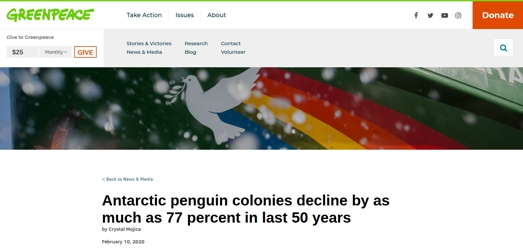Where’s the paper?
Does Greenpeace expect us to accept their numbers without demur? To accept the cause they suggest? When can we question the researchers? A few inquiries raise serious questions about the study’s credibility. This is how the story begins on the Greenpeace website, with the headline shown in the screen grab:
February 10, 2020 – Scientists surveying chinstrap penguin colonies in the Antarctic have found drastic reductions in many colonies, with some declining by as much as 77 percent since they were last surveyed almost 50 years ago.
The independent researchers, on a Greenpeace expedition to the region, found that every single colony surveyed on Elephant Island, an important habitat northeast of the Antarctic Peninsula, had declined. The number of chinstrap penguins on Elephant Island has dropped almost 60 percent since the last survey in 1971, with a total count of only 52,786 breeding pairs of chinstrap penguins, plummeting from previous survey estimates of around 122,550 pairs.
People reading no further than the headline will get the impression of a serious, continent-wide decline in all Antarctic penguin species over half a century.
But it cannot be true.
The chinstrap penguin is the most abundant penguin species on the planet. Its colonies surround Antarctica and include sub-Antarctic islands and South Africa.
An undated estimate on Seaworld’s website gives the world-wide chinstrap population between 13,000,000 and 15,000,000 birds and states the birds are “not listed” on the Red List. However, by 2018 the IUCN Red List of Threatened Species reported the global population at 8,000,000 birds and said it’s “declining” but of “least concern”. That’s an optimistic estimate just two years ago from an organisation whose core business is frank alarm.
I don’t know how many singletons to expect in a sample of 15 million healthy chinstrap penguins, but if 50% were unattached, that would mean 3,750,000 breeding pairs. Taking the Red List figure of 8 million for the total population gives 2,000,000 breeding pairs. Those figures would mean the latest expedition, announcing 52,786 pairs, may have counted only 1.3% or 0.7% of the chinstrap population. I’m thinking neither is a meaningful sample, but I don’t know.
The reduction reported by the Greenpeace expedition over 50 years does not square with the figures from Seaworld and the IUCN in apparently the last couple of years, so either way the estimates must be reconciled.
What’s the cause?
Dr Heather J. Lynch, Associate Professor of Ecology & Evolution at Stony Brook University, one of the expedition’s leads, said: “Such significant declines suggest that the Southern Ocean’s ecosystem is fundamentally changed from 50 years ago, and that the impacts of this are rippling up the food web to species like chinstrap penguins. While several factors may have a role to play, all the evidence we have points to climate change as being responsible for the changes we are seeing.”
Really? What other factors? For example, has predator behaviour changed, perhaps through over-fishing? Has food supply been compromised? Have other penguins, perhaps the Gentoo, moved in to compete with the chinstrap? What about disease?
Please tell us what evidence points to climate change, apart from your own ideologically derived expectations?

Though they haven’t shown you a single piece of evidence for it, Greenpeace want you to believe the planet faces disaster. Note that: not merely a setback, but actual disaster. See their advert (at right) on the website. The word they use is ‘disaster’.
Are you so easy to persuade?
If you believe what they say without evidence, you must accept that Greenpeace is a religion and not a science.
Views: 5


There’s real competitive bed-wetting going on between the “experts”. ….
https://www.tvnz.co.nz/one-news/world/south-pole-could-disintegrate-if-antarcticas-record-breaking-warmth-keeps-up-experts
I’ve been looking at that TV1 story, Mack. It’s incompetent on several levels. I’m not sure I have time to write about it, but I’ll try.